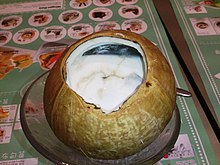abinung

tadatakalaw ku langaw nina abinung.
tabaki ku heci nu abinung. u pudac nu abinung sa u landaway. a'su mukan nu labu'ay. sikabi, siheci. u sangelacay ku ilabu'ay.
katuud ku pacakay abinung i Pingtung. hali caledesay a demaid. anu mahetik i bayu', taneng munabaw i bayu' tayza i baat a subal katakit.
i Taykoku muculcul tu ungay mukayakay tu abinung tapabaw miala th heci.
u cudadan a ngangan sa u Cocos nucifera.
u sulit nu zuma a kamu
[mikawaway-kalumyiti | mikawaway tu kalumyiti sakatizeng bangu]u sulit nu Hulam
[mikawaway-kalumyiti | mikawaway tu kalumyiti sakatizeng bangu]椰(學名:Cocos nucifera)是棕櫚科椰屬的唯一種大型植物,椰子是椰樹的果實,是一種在熱帶地區很普及的果實。椰子樹的普及也在於其果實椰子可以在海中隨風浪漂流上千公里後生殖到離母樹非常遠的地方。一般商業賣出來的椰子在收割時還是綠色的,未成熟的果實,它有點三角形狀,足球大小。在泰國南部人們也利用訓練好的獼猴來採摘椰子。
u sulit nu Lipun
[mikawaway-kalumyiti | mikawaway tu kalumyiti sakatizeng bangu]ココナッツはヤシ科の単子葉植物、ココヤシの果実である。ココナツあるいは、単に椰子の実ともいう。
u sulit nu Amilika
[mikawaway-kalumyiti | mikawaway tu kalumyiti sakatizeng bangu]
The coconut tree (Cocos nucifera) is a member of the family Arecaceae (palm family) and the only species of the genus Cocos. The term coconut can refer to the whole coconut palm or the seed, or the fruit, which, botanically, is a drupe, not a nut. The spelling cocoanut is an archaic form of the word. The term is derived from the 16th-century Portuguese and Spanish word coco meaning "head" or "skull", from the three indentations on the coconut shell that resemble facial features.
malalitin tu ihekalay atu zumaay a natinengan
[mikawaway-kalumyiti | mikawaway tu kalumyiti sakatizeng bangu]- 中國數字植物標本館中的相關內容:椰
- (繁體中文)(英文)椰子, Yezi 藥用植物圖像資料庫 (香港浸會大學中醫藥學院)

